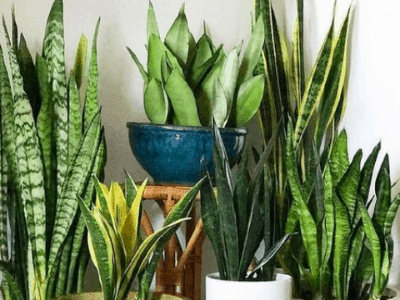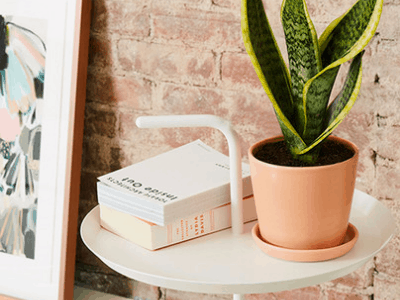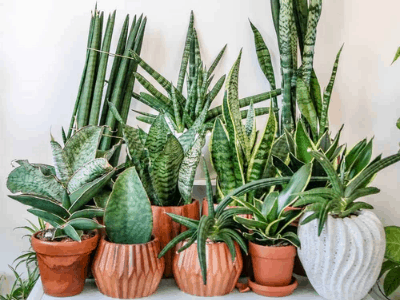
Sansevieria (Snake Plant) is a perennial with a long history. This evergreen plant was named….
..after Italian inventor Raimondo di Sangro, Prince of San Severo by Swedish botanist Carl Peter Thunburg (1710-1771).
The snake plant has been grown for more than 250 years and has been in the US foliage trade since the 1920s.
Where Do These Plants Come From?
The Snake Plant is native to arid regions of Africa, Madagascar, and southern Asia, and can often be found…
…in the shade of a larger tree or shrub. Many Snake Plant species resemble agaves or yuccas…
…which are also plants native to the same regions.
Snake Plants use the Crassulacean Acid Metabolism (CAM) photosynthesis process to survive heat and drought.
CAM-using plants absorb carbon dioxide during the day and release oxygen at night.
They close their stomata during the day to conserve water and open them at night to store CO2 in the form of an organic acid.
The plants use the acid for their photosynthetic needs the next day.
Snake Plants are extremely hardy and long-lived because of this. In the right circumstances…
…some people can live for decades. Here we have story from Martinn, about his experience having a snake plant..
…as his houseplant and having a good air circulation and purification after having snake plant around his house!
Let us hear Martin’s story
I was walking down the aisle of my local garden store when I saw a new house plant on sale.
It’s called snake plant (sansevieria trifasciata, also known as mother-in-law’s tongue). It seemed a bit pricey at first…
...but then I noticed that it had some other benefits besides just decorating my home.
Snake Plant is an air purifier! Plus it looks really nice and can be grown in any type of soil or water condition.
The only downside is that if you want to grow one for your house make sure you put them in a room…
…with no windows because they don’t like natural light.

Similar to other household succulents, snake plants help to filter indoor air. What’s unique about this particular plant is that it’s one of the few plants that can convert carbon dioxide (CO2) into oxygen at night. This quality makes it an ideal plant for bedroom decor as it can help regulate healthy airflow.
Scott Frothingham, author from healthline.com
Here’s the main story…
7 Things You Can Do With Snake Plants
According to Ambius, Snake Plants can be used for more than just a visual pop.
There are seven interesting ways you can use your plant for more than its good look. Here’s the list of what you can do to the snake plants:
- Treat illnesses like coughing and inflammation of the respiratory tract by using the leaves and roots.
- A number of African countries have used fibers from Sansevieria plants for slings and ropes for baskets for generations. Sansevieria plants can be found for sale worldwide.
- The durable leaves can also be used to make bandages for first aid kit.
- Koreans use plant species as a symbol of a strong relationship that endures difficult circumstances.
- Consider purifying your air by placing Snake Plants in your bedroom if you want to make your home a better place to sleep at night. This plant is one of our top 8 plants to use to purify the air indoors, according to a NASA study. It removes formaldehyde, trichloroethylene, xylene, toluene, and benzene from the air during the night. For optimal oxygen quality, consider placing 6 to 8 waist-high plants per person in your home. You can also use one in your bathroom to eliminate formaldehyde, which is found in many cleaning products.
- Many experts believe the presence of this plant near schools will decrease abrasive behavior.
- Incorporate Sansevieria into your office’s feng shui! Spiky plants, such as the Sansevieria, are thought to have strong protective energies that may be beneficial when setting up sensitive business deals in your office, and shielding yourself from negative chi may improve your luck. Place the plants in the southeast, southern, and eastern corners of your office or home.
Due to its low maintenance requirements, you might think that Snake Plants would have affectionate nicknames…
….but unfortunately that’s not the case. It’s also known as Snake Tongue, Mother-in-law’s Tongue and Devil’s Tongue…
…which are names thought to reflect the sharp qualities of the plant and the physical way its dense leaves stand…
…and point up and away from the basal rosette.

Go on…

Planting Instruction and Care
Regardless of the light or moisture exposure, your snake plant will probably flourish.
The popularity of the plant is based both on the beauty and robustness of its profoundly shaded green leaves and height.
It can be placed in environments from very bright light to rooms with almost no sunlight and it will adjust…
…but they are better suited to indirect, constant light in rooms.
They prefer temperatures between 70 and 90 degrees Fahrenheit, and will not tolerate temperatures below 50…
…or a spot near a drafty window. If you grow a snake plant outside in a garden keep it in a container to prevent it from spreading:
Watering and Nutrients
An overwatered snake plant does not tolerate it. It will rapidly develop root rot if the soil is too damp.
In case of doubt, err on the underwater side and do not depend on the surface of the ground as the dryness indicator.
To make sure that you don’t feel any moisture until waters, you must put your finger four inches in the ground.
A snake plant kept in bright light would need to be watered more often than one kept in a darker setting.
A snake plant should not be watered more than once every two weeks, and some can go up to six weeks…
…without having to be watered. The plant would need even less water in the winter.
Fertilizers made for cacti work well with snake plants (1-7-6). Snake plants can only be fertilized during…
….the growing season. If you’re going to use a slow-release fertilizer, dilute it to half strength first.
Snake Plant Is Though
Snake plants are drought resistant and seem to prefer to remain on the dry side.
Plant them in soil that is loose and drains well. A commercially prepared cactus mix is a good choice…
…as are other soils on the sandy side. The roots of the snake plant are extremely strong…
…so you should plant them in sturdy pots devoid of cracks as their roots grow.
Terra cotta pots are a good choice, as they are lightweight and absorb excess water.
A snake plant kept in the sunshine will grow quickly, so anticipate repotting or dividing it once or twice a year…
….preferably in the spring. If your plant is pot bound it may flower.
Whenever you repot, provide your plant with fresh potting soil, and don’t bury them too deeply.
It’s a good idea to wipe down your leaves every once in a while, as they do collect dust.
Choose a container that has drainage holes in the bottom.

Next up…
Watering and Nutrients
An overwatered snake plant does not tolerate it. It will rapidly develop root rot if the soil is too damp.
In case of doubt, err on the underwater side and do not depend on the surface of the ground as the dryness indicator.
To make sure that you don’t feel any moisture until waters, you must put your finger four inches in the ground.
A snake plant kept in bright light would need to be watered more often than one kept in a darker setting.
A snake plant should not be watered more than once every two weeks, and some can go up to six weeks without having to be watered.
The plant would need even less water in the winter. Fertilizers made for cacti work well with snake plants (1-7-6).
Snake plants can only be fertilized during the growing season. If you’re going to use a slow-release fertilizer, dilute it to half strength first.
Propagation
Snake plants are very simple to propagate, especially through plant division.
The rapid growth of a plant in a container in a sunny location can necessitate division.
Unpotting a plant and splitting the root ball and leaves into many divisions is the simplest way to separate it.
The roots and leaves will separate, and the plant will be ready for repotting.
Cuttings may also be used to spread snake plants. Simply snip off the top few inches of a leaf and drop it…
….in the soil or into a cup of water. It may grow roots, but this method may take longer and may result…
…in the loss of the plant’s distinctive markings.
Keep reading…
Pruning
Snake plants don’t need any pruning beyond removing any dead leaves or improving the plant’s appearance.
To ensure that the plant devotes its resources to safe new growth rather than repairing injuries…
…it is a good idea to remove damaged leaves.
Pests, Diseases, and Animals
The snake plant’s hardiness extends to its pest and disease tolerance. Root rot can cause leaves to become soft…
…or brown, which you can treat by removing any infected leaves with a sharp scissor and allowing the plant to dry out.
Insect infestations are uncommon on snake plants. If mealybugs or spider mites appear…
…use neem oil or a solution of liquid soap and water to wipe down the leaves.
Light
The Snake Plant is extremely adaptable. While it can tolerate full sun, it prefers and thrives in indirect sunlight…
…and grow light. This makes it suitable for indoor cultivation. Indoor artificial lighting, such as fluorescent bulbs…
…used in most offices and homes, can provide enough light for this plant to thrive.
However, you’ll need more light intensity and duration to make it expand faster and more vigorously.
Last but not least..
Flowering
Snake plant flowers range in color from green to white. Moths pollinate them in the open air.
After fruiting, these plants are known to produce very few seeds. When a shoot blooms, it stops producing flowers…
….and instead produces small plants that emerge from the rhizomes.
Sum Up
See having Snake plant is good choice for you to have! It’s cool, its famous, it’s easy to have and care!
What else do you need? In this pandemic time like this, is a good choice for you to have an new activity…
…and having snake plant is a good choice for you to have!
Conclusion
Last thing for sure. This plant need to be care carefully, remember plant need the “love” too.
Alright that’s all for today! Do you have any questions about all of this?
Or do you want to add some more benefits for having snake plant around as your houseplant?
Let me know your recommendation from the comment below.
I hope you can now take care your snake carefully and grow it big!
Thanks for reading this article! Bye!

